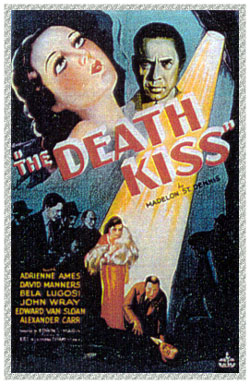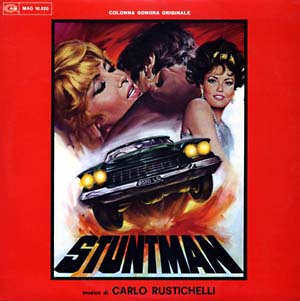 BY DAN BUSKIRK FILM CRITIC The filmmakers turn their cameras both inward and outward in yet another improbable triple-feature mounted by Andrew’s Video Vault. In Richard Rush’s The Stunt Man and the surprisingly plush Poverty Row programmer The Death Kiss treachery descends during a film’s shooting while the mid-seventies goofball comedy Drive-In gently satirizes the Texas townsfolk who meet up one night while watching movies in their cars under the stars. And you can call this a double triple-feature, each film has its own movie-within-the-movie.
BY DAN BUSKIRK FILM CRITIC The filmmakers turn their cameras both inward and outward in yet another improbable triple-feature mounted by Andrew’s Video Vault. In Richard Rush’s The Stunt Man and the surprisingly plush Poverty Row programmer The Death Kiss treachery descends during a film’s shooting while the mid-seventies goofball comedy Drive-In gently satirizes the Texas townsfolk who meet up one night while watching movies in their cars under the stars. And you can call this a double triple-feature, each film has its own movie-within-the-movie.
First up is the best remembered of the bunch; Richard Rush’s euphoric meditation on the illusion of moviemaking, The Stunt Man has endured as a true cult favorite. Intensity personified, Steven Railsback (forever shadowed by his eerily dead-on performance as Manson in the original TV movie Helter Skelter) is an escaped con on the run and hiding out on a movie set. Peter O’Toole is the charismatic director Eli Cross who recruits Cameron to fill in for a recently-killed stunt man. Railback’s encyclopedic collection of nervous tics do battle with O’Toole’s pompous speechifying as Cameron begins to suspect that Cross is out to kill him during filming. While director Cross is manipulating his nervous mouse Cameron, director Rush is toying with us, switching between Cameron’s reality and movie illusions without warning. It’s the kind of playful trick that movie-lovers squeal about which is why The Stunt Man continues to attract fans with its vision of filmmaking as a ecstatic craft where anything is possible. It was nominated for Oscars for directing, writing and for giving Peter O’Toole the rare part grandiose enough for the legendary Irish rogue to inhabit. Come to mention it the whole film is big, far too big to be given justice on the small screen.
The Stunt Man has endured as a true cult favorite. Intensity personified, Steven Railsback (forever shadowed by his eerily dead-on performance as Manson in the original TV movie Helter Skelter) is an escaped con on the run and hiding out on a movie set. Peter O’Toole is the charismatic director Eli Cross who recruits Cameron to fill in for a recently-killed stunt man. Railback’s encyclopedic collection of nervous tics do battle with O’Toole’s pompous speechifying as Cameron begins to suspect that Cross is out to kill him during filming. While director Cross is manipulating his nervous mouse Cameron, director Rush is toying with us, switching between Cameron’s reality and movie illusions without warning. It’s the kind of playful trick that movie-lovers squeal about which is why The Stunt Man continues to attract fans with its vision of filmmaking as a ecstatic craft where anything is possible. It was nominated for Oscars for directing, writing and for giving Peter O’Toole the rare part grandiose enough for the legendary Irish rogue to inhabit. Come to mention it the whole film is big, far too big to be given justice on the small screen.
Thursday July 12th 2007 8PM
THE DEATH KISS (1932, directed by Edwin L. Marin, 74 minutes, U.S.)
DRIVE-IN (1976, directed by Rodney Amateau, 96 minutes, U.S.)
Following The Stunt Man is The Death Kiss, one of ten films Bela Lugosi made in 1932, the year following his breakout performance as Dracula. He’s merely one of many shady suspects (along with Dracula co-stars David Manners and Edward Van Sloan) who are present when one of the studio’s leading men is gunned down during a film’s shoot-out. As far as low-budget early talkies go, The Death Kiss is a small gem, its camerawork  uncharacteristically fluid for the era while the script is full of cheap yucks at the expense of the studio’s employees. Already the stereotypical Hollywood types are in place, the Jewish studio owner cutting corners at the expense of art, effeminate stage hands, vain actors and the no-nonsense cops who’ve had it up to here with all these showbiz types. In no time flat this economical wonder zooms to its startling conclusion and not before a few zips of tinted color flash by when the action heats up.
uncharacteristically fluid for the era while the script is full of cheap yucks at the expense of the studio’s employees. Already the stereotypical Hollywood types are in place, the Jewish studio owner cutting corners at the expense of art, effeminate stage hands, vain actors and the no-nonsense cops who’ve had it up to here with all these showbiz types. In no time flat this economical wonder zooms to its startling conclusion and not before a few zips of tinted color flash by when the action heats up.
Before the final curtain falls the most obscure of the features, Rodney Amateau’s Drive-In will have the rarest of screenings. Long-unavailable on home video, Drive-In was shot at a outdoor screen east of Dallas, Texas in the mid-seventies. Like a farm league American Graffiti Amateau follows assorted small town characters as they paint the town Southern-style over the course of a Friday Night. Without a single star to hang these hi-jinks on, Drive-In has a regional flavor that has only made it more hickory-smoked savory as the years have passed. Sure, Skatetown U.S.A. is a stone-cold classic but if you want a real 70’s time-warp look at the population of Terrell Texas-born extras as the skate their immaculately feathered seventies haircuts in circles around you at the local roller rink. Richard Linklater labored painstakingly to conjure a dead end Texas town like this in his stoner comedy Dazed and Confused, that same “too Seventies for words” mise en scene spills out of Drive-In as easily as the Rio Grande rolls into Mexico.
A bushy-haired redheaded guy woos the town bully’s ex-girlfriend! Important meeting are held in the back of a shag-carpeted van! Bumbling crooks conspire to rob the drive-in! These bits are juggled pretty effortlessly as the movie unreeling (Disaster ’76, a funny spoof that razzes Airport, Jaws, and The Towering Inferno while oddly prophesying the movie Airplane and the 9-11 disaster) intermittently comments on the action.
That Drive-In ambles along so breezily is no happy accident, it’s the work of an unacclaimed but solid journeyman, Rod (The Garbage Pail Kids Movie) Amateau. His direction is so fresh and energetic you’d think it was some talented recent film school graduate who was getting such low-key yet nuanced performances out of the local population. No, Amateau was in his fifties when he made Drive-In, and during his inauspicious yet fascinating career he had worked with bad boy genius Nick Ray on In A Lonely Place, directed numerous Dobie Gillis and Gilligan’s Island episodes, toiled under mad man Sam Peckinpah, scripted one of Jerry Lewis’ worst films (Hook, Line & Sinker) and married George Burns and Gracie Allen’s daughter. Here’s a man who must have known something about living and like a less ambitious Robert Altman he gets to show you a little of what he has observed through the mix of characters we meet, all of them just here to see the movie like we are.
